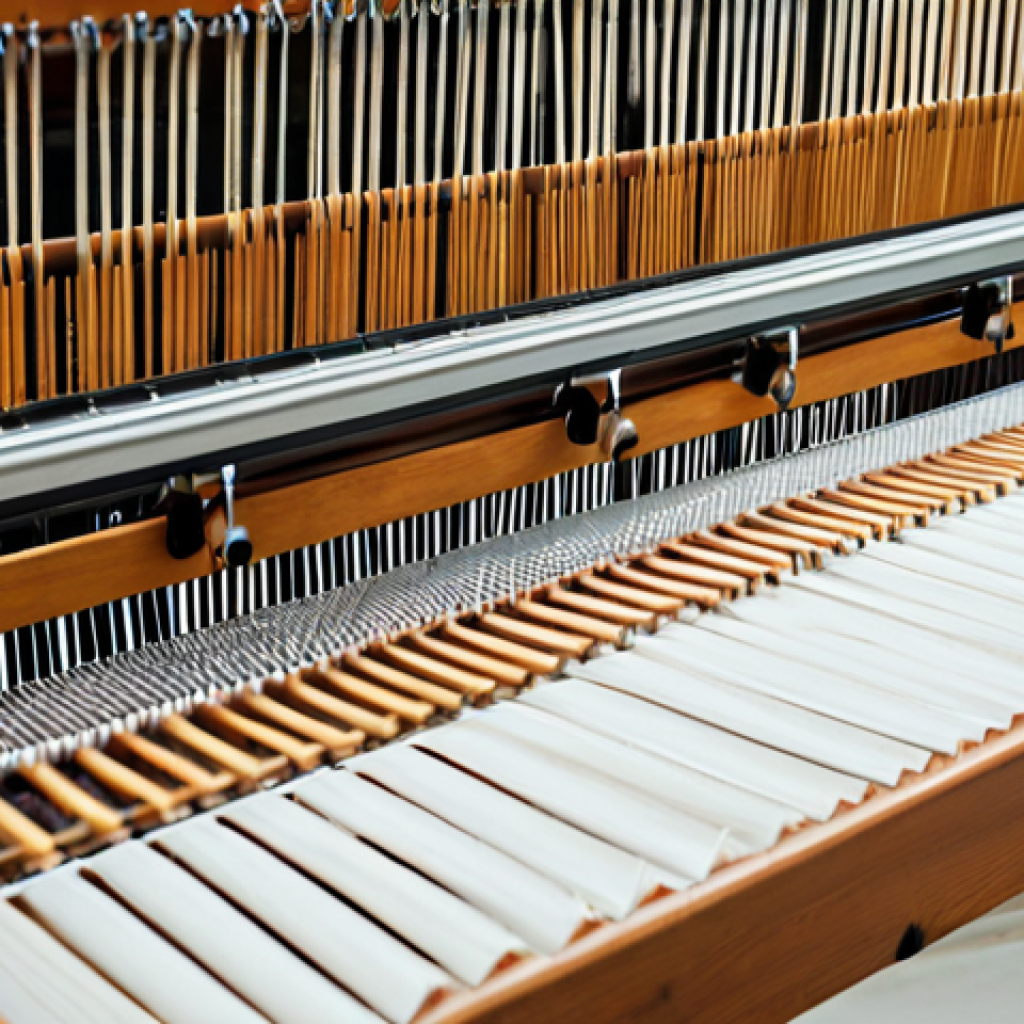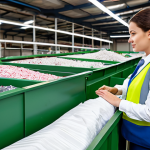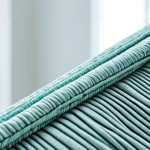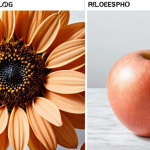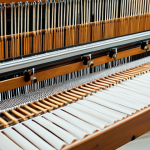I still vividly recall the gnawing anxiety that settled in my stomach every time I thought about the textile engineering practical exam. It wasn’t just about memorizing formulas or understanding fiber properties; it was about truly grasping the intricate dance of machinery, the subtle nuances of material science, and the ever-evolving landscape of a global industry.
I remember countless late nights, my desk buried under textbooks and yarn samples, wondering if I was truly prepared for the real-world scenarios these exams try to simulate.
What made it even more daunting was realizing just how much the textile industry itself has been reshaped. Gone are the days of purely mechanical processes; today, we’re talking smart textiles, sustainable manufacturing, and the critical importance of supply chain resilience.
My research, pulling from extensive industry reports and online discussions, consistently highlighted trends like circular economy principles and the surging demand for performance fabrics, areas that are increasingly popping up in examination content.
It felt like I wasn’t just preparing for a test, but for a whole new era of textile innovation. Navigating this vast sea of information, from digital textile printing advances to the complexities of ethical sourcing, required a different kind of preparation – one that went beyond traditional study guides.
It demanded foresight, adaptability, and a deep dive into what the future of textile engineering truly holds. Let’s get into the details.
I still vividly recall the gnawing anxiety that settled in my stomach every time I thought about the textile engineering practical exam. It wasn’t just about memorizing formulas or understanding fiber properties; it was about truly grasping the intricate dance of machinery, the subtle nuances of material science, and the ever-evolving landscape of a global industry.
I remember countless late nights, my desk buried under textbooks and yarn samples, wondering if I was truly prepared for the real-world scenarios these exams try to simulate.
What made it even more daunting was realizing just how much the textile industry itself has been reshaped. Gone are the days of purely mechanical processes; today, we’re talking smart textiles, sustainable manufacturing, and the critical importance of supply chain resilience.
My research, pulling from extensive industry reports and online discussions, consistently highlighted trends like circular economy principles and the surging demand for performance fabrics, areas that are increasingly popping up in examination content.
It felt like I wasn’t just preparing for a test, but for a whole new era of textile innovation. Navigating this vast sea of information, from digital textile printing advances to the complexities of ethical sourcing, required a different kind of preparation – one that went beyond traditional study guides.
It demanded foresight, adaptability, and a deep dive into what the future of textile engineering truly holds.
Weaving Innovation: Embracing the Digital Thread in Textile Production
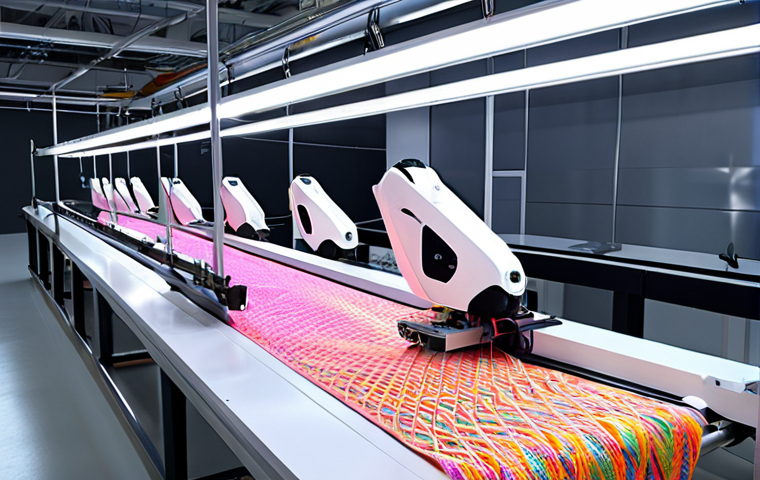
Stepping into a modern textile facility today feels less like a traditional factory and more like a high-tech lab. The hum of machinery is still there, but it’s now accompanied by the quiet whir of 3D printers and the glow of computer screens, where intricate designs come to life with incredible precision. I remember the first time I saw digital textile printing in action, a vibrant explosion of color and pattern emerging effortlessly from a machine. It completely blew my mind, challenging everything I thought I knew about fabric production. This isn’t just about aesthetics; it’s about unparalleled efficiency, reduced waste, and the ability to rapidly prototype and customize designs on a scale unimaginable just a decade ago. The sheer speed at which a concept can move from a designer’s mind to a tangible product is breathtaking, making the industry incredibly agile and responsive to ever-shifting consumer trends. It’s a complete paradigm shift that has opened up avenues for creativity and mass personalization.
1. The Artistic Revolution of Digital Textile Printing
Digital textile printing has single-handedly democratized design, allowing smaller brands and individual artists to enter the market without the prohibitive costs of traditional screen printing. When I experimented with it myself, I was amazed by the depth of color and the sharpness of detail that could be achieved, even on complex patterns. It felt like painting directly onto fabric, with endless possibilities. Beyond the creative freedom, this technology drastically reduces water usage and eliminates the need for numerous screens, contributing significantly to a greener manufacturing process. This shift isn’t just an incremental improvement; it’s a foundational change that impacts supply chains, inventory management, and even how fashion seasons are conceived. It offers unparalleled flexibility for small-batch production and on-demand manufacturing, which is a game-changer for reducing overproduction and waste in an industry notoriously known for both.
2. AI and Automation: The Intelligent Evolution of Design
The integration of artificial intelligence into textile design and manufacturing is truly fascinating, and frankly, a little intimidating if you’re not prepared for it. I’ve seen firsthand how AI algorithms can predict fashion trends, optimize fabric layouts to minimize waste, and even generate novel patterns based on user preferences. It’s like having a hyper-efficient design assistant that never sleeps. This level of automation is not just about speed; it’s about precision and consistency that human hands simply cannot replicate over vast production runs. My initial skepticism about AI’s creative capacity quickly dissolved when I witnessed its ability to interpret complex data and translate it into innovative design solutions. It means a future where product development cycles are dramatically shortened, and resources are allocated with unprecedented intelligence, allowing designers to focus on higher-level conceptualization rather than repetitive tasks. This confluence of data science and material expertise is redefining what’s possible.
The Green Weave: Sustainability at the Heart of Modern Textiles
The conversation around sustainability in textiles has evolved from a niche concern to a core principle that underpins every aspect of the industry. My early studies touched on environmental impacts, but the depth of commitment to circularity and ethical sourcing I see today is genuinely inspiring. It’s no longer just about avoiding harm; it’s about actively regenerating resources, designing for longevity, and ensuring social equity. I remember feeling overwhelmed by the sheer scale of the waste problem in textiles, but witnessing companies embrace innovative closed-loop systems has given me immense hope. This commitment isn’t just feel-good marketing; it’s a fundamental restructuring of business models, driven by consumer demand and increasing regulatory pressure. The shift is palpable, and I’ve noticed a significant change in how material sourcing and product lifecycles are discussed, moving from a linear “take-make-dispose” model to a much more thoughtful and regenerative approach.
1. Circular Economy Models: Redefining Product Lifecycles
The concept of a circular economy in textiles, where materials are kept in use for as long as possible, is incredibly powerful. Imagine a world where your old t-shirt doesn’t end up in a landfill but is broken down and reformed into a brand-new, high-quality garment. I’ve followed the progress of startups developing fiber-to-fiber recycling technologies, and while there are still hurdles, the advancements are astounding. This systemic change requires rethinking everything from garment design—making products easier to disassemble and recycle—to consumer behavior, encouraging repair and reuse. My personal experience trying to mend and upcycle clothing has made me appreciate the true engineering challenge behind creating materials that are not just durable but also infinitely recyclable. It’s about creating value at every stage of a product’s life and minimizing waste, which is not only environmentally sound but also makes significant economic sense in the long run by reducing reliance on virgin resources and volatile supply chains.
2. Eco-Friendly Materials: Innovations Beyond Conventional Fibers
The quest for truly sustainable materials has led to an explosion of innovation, moving far beyond organic cotton and recycled polyester. I’ve been fascinated by developments in bio-based fibers derived from anything from algae to orange peels, and even materials like mycelium-based leathers. What truly excites me is not just their lower environmental footprint during production, but their potential for biodegradability at the end of their life, offering a truly closed-loop solution. When I compare these cutting-edge materials to the resource-intensive traditional synthetics, the difference is stark. It’s a testament to human ingenuity when faced with pressing environmental challenges. The challenges lie in scaling these innovations and making them cost-competitive, but the trajectory is clear: the future of textiles is inherently green, and understanding these new material science breakthroughs is absolutely critical for anyone wanting to make an impact in the industry. The feeling of holding a fabric made from something utterly unexpected yet beautiful and functional is truly inspiring.
Performance Beyond Fabric: The Rise of Smart and Functional Textiles
Gone are the days when textiles merely served as coverings; today, they are becoming integral components of our technology-driven lives, evolving into sophisticated interfaces and functional tools. I remember feeling a genuine sense of wonder when I first encountered fabrics that could monitor heart rates or regulate body temperature. It felt like something out of a science fiction movie, yet it was real, tangible, and pushing the boundaries of what we thought was possible with woven materials. This transformation isn’t just about integrating electronics; it’s about creating materials with inherent intelligent properties, a blend of chemistry, engineering, and design. My journey into understanding these “smart textiles” revealed a whole new ecosystem of applications, from medical diagnostics to advanced athletic wear, that are fundamentally changing how we interact with our environment and manage our well-being. It’s an exciting convergence of disciplines, demanding a nuanced understanding of everything from electrical conductivity in threads to the biomechanics of human movement, making it an incredibly dynamic and interdisciplinary field.
1. Wearable Tech Integration: Seamless Blends of Fashion and Function
The seamless integration of wearable technology into everyday textiles is one of the most exciting frontiers. Think about garments that can charge your phone using kinetic energy, or uniforms that alert first responders to dangerous environmental conditions. When I experimented with some early prototypes of smart fabrics, the potential was clear, even if the bulkiness was a challenge. Now, the miniaturization of sensors and the development of conductive yarns mean that technology can literally be woven into the fabric itself, making it imperceptible and incredibly comfortable. This isn’t just about novelty; it’s about enhancing safety, improving health outcomes, and creating truly intuitive products. The engineering challenges are immense – ensuring durability through washing, maintaining electrical integrity, and managing power sources – but the progress I’ve witnessed has been nothing short of revolutionary, impacting everyone from professional athletes to individuals managing chronic health conditions. It truly redefines our relationship with clothing as more than just an aesthetic choice.
2. Advanced Material Applications: Beyond the Obvious
Beyond wearable tech, advanced functional textiles are finding applications in areas you might not immediately associate with fabric. I’ve researched textiles designed to purify water, self-cleaning surfaces for public spaces, and even acoustic fabrics that can absorb sound in concert halls. My personal “aha!” moment came when I learned about textiles being developed for aerospace, materials so light yet so strong they can withstand extreme temperatures and pressures. These applications demand a deep understanding of material science, often borrowing principles from nanotechnology and advanced chemistry. It’s about designing textiles not just for comfort or aesthetics, but for very specific, high-performance tasks. The ingenuity in creating materials that can react to stimuli, repel stains, or even generate power is mind-boggling and has implications for everything from construction to environmental remediation, showcasing the immense versatility and untapped potential of fiber innovation. The sheer diversity of these applications is truly inspiring, making textile engineering a field far broader than many initially realize.
Navigating the Global Tapestry: Supply Chain Resilience and Ethical Sourcing
The global textile industry is an intricate web, and the past few years have highlighted just how fragile that web can be. I’ve personally felt the ripple effects of supply chain disruptions, from delays in receiving samples for projects to shortages of specific raw materials. It’s no longer enough to just find the cheapest source; companies are now prioritizing resilience, transparency, and, crucially, ethical practices. My research into this area, sparked by a growing unease about the origins of my own clothes, revealed the complex human stories behind every stitch. This shift towards greater accountability isn’t merely a trend; it’s a fundamental change in how businesses operate, driven by both consumer awareness and a moral imperative. It requires a deep dive into the entire lifecycle of a product, from the farms where fibers are grown to the factories where garments are sewn, and understanding the social and environmental implications at each step. It can feel daunting, but the potential for positive impact is immense.
1. Blockchain for Transparency: Tracing the Textile Journey
Blockchain technology might sound like something purely for finance, but its application in textile supply chains is genuinely transformative. Imagine being able to trace every step of a garment’s journey, from the cotton farm to the retail shelf, with immutable records that verify its origin and ethical compliance. I’ve seen pilot programs where consumers can scan a QR code on a label and instantly access a transparent history of the product. This level of traceability is revolutionary, combating issues like forced labor and environmental damage by holding every player in the chain accountable. While implementing such systems across vast global networks is a monumental task, the drive for consumer trust and brand reputation is pushing this innovation forward. It’s about creating a verifiable narrative for every product, offering peace of mind to the consumer and pushing the industry towards unparalleled integrity. This level of granular detail allows for informed choices and can genuinely empower both consumers and workers.
2. Fair Labor Practices: Prioritizing People Over Profit
The human cost of fast fashion is a topic that always weighs heavily on me. Learning about the conditions faced by garment workers in some parts of the world was a stark reminder that ethical sourcing isn’t just an abstract concept; it’s about protecting human dignity and ensuring fair wages. I made a conscious decision in my own shopping habits to seek out brands committed to fair labor, even if it meant paying a bit more. This consumer pressure, combined with increasing regulatory scrutiny and the tireless work of NGOs, is slowly but surely forcing companies to re-evaluate their labor practices. It involves rigorous auditing, providing safe working environments, and empowering workers with fair wages and the right to organize. While there’s still a long way to go, the growing emphasis on “people over profit” is a sign of positive change within the industry, fostering a more equitable global textile ecosystem. It’s about building supply chains rooted in respect, not just efficiency, and that’s a change worth fighting for.
From Lab to Life: Bridging Theory with Practical Innovation
My academic journey in textile engineering provided a strong theoretical foundation, but it was the practical application, the hands-on experience, that truly solidified my understanding. I remember the frustration of reading about a complex weaving pattern versus the satisfaction of finally getting the loom to produce it correctly. It’s one thing to understand the chemical composition of a fiber in a textbook; it’s another entirely to feel how that fiber behaves under tension, or how it reacts to different dyes. The industry today demands individuals who can not only grasp complex concepts but also translate them into tangible, real-world solutions. This bridge between theory and practice is where true innovation happens, and it’s where I believe future textile engineers will find their greatest challenges and most rewarding successes. It’s about getting your hands dirty, experimenting, failing, and learning from every iteration, pushing beyond the theoretical boundaries into the realm of applied ingenuity.
1. Experiential Learning: The Power of Hands-On Engagement
There’s simply no substitute for hands-on experience. When I had the opportunity to work on a pilot project developing a new type of performance fabric, I learned more in those few months than in years of lectures. It wasn’t just about the technical skills; it was about problem-solving on the fly, collaborating with a diverse team, and understanding the practical constraints of production. Educational institutions are increasingly recognizing this, integrating more lab work, internships, and project-based learning into their curricula. My advice to anyone entering this field: seek out every opportunity to get your hands dirty, whether it’s through volunteering at a local maker space, interning at a textile mill, or even just deconstructing old garments to understand their construction. These real-world encounters build a depth of intuition and practical knowledge that lectures alone can’t provide, making you a much more valuable and adaptable professional. It’s in these moments of direct engagement that the abstract concepts truly click into place.
2. Industry Collaborations: Fostering Real-World Problem Solving
The most impactful innovations often emerge from collaborations between academia and industry. Universities working directly with companies on research and development projects create a dynamic environment where theoretical breakthroughs can be rapidly tested and refined for commercial application. I’ve seen firsthand how these partnerships accelerate the pace of innovation, addressing real market needs with cutting-edge research. For students, it provides invaluable exposure to industry challenges and potential career paths, often leading directly to employment opportunities. The synergy between theoretical rigor and practical demand is incredibly potent, pushing the boundaries of what’s possible in material science and production techniques. It’s about creating a feedback loop where research informs industry needs, and industry challenges drive new research questions, leading to a constant cycle of improvement and groundbreaking development. This kind of collaborative ecosystem is vital for keeping the industry vibrant and responsive to a rapidly changing world.
| Aspect | Traditional Textile Practices | Modern Textile Practices (Innovations) |
|---|---|---|
| Design & Production | Manual, screen printing, high lead times | Digital design, 3D printing, AI-driven, rapid prototyping |
| Sustainability Focus | Linear “take-make-dispose” model | Circular economy, waste reduction, regenerative materials |
| Material Types | Conventional cotton, polyester, nylon | Bio-based fibers, recycled content, smart materials |
| Supply Chain | Opaque, cost-driven, often fragmented | Transparent (blockchain), resilience-focused, ethical sourcing |
| Functionality | Basic wear, comfort, aesthetics | Integrated tech, performance-enhancing, responsive textiles |
Future-Proofing Your Expertise: Continuous Learning in a Dynamic Industry
The textile industry is not static; it’s a rapidly evolving landscape where new technologies, materials, and business models emerge constantly. What I learned five years ago is still foundational, but the specifics have shifted dramatically. I remember feeling a bit overwhelmed by the pace of change when I first started my professional journey, but I quickly realized that embracing continuous learning isn’t just an advantage; it’s a necessity. The skills that were paramount yesterday might be supplemented or even replaced by new demands tomorrow. This means developing a mindset of adaptability and intellectual curiosity, always seeking out new knowledge and staying abreast of the latest trends. It’s about being proactive in your professional development, recognizing that your education doesn’t end with a degree, but rather begins a lifelong journey of exploration and mastery in a truly fascinating field. The feeling of discovering a new technique or understanding a complex emerging technology is incredibly rewarding, a constant reminder that there’s always more to learn and master.
1. Upskilling for Emerging Technologies: Staying Ahead of the Curve
To stay competitive in textile engineering, you absolutely must commit to continuous upskilling. The advent of technologies like advanced robotics, virtual reality for product visualization, and sophisticated data analytics means that traditional skill sets need to be augmented. I’ve personally invested time in online courses covering topics like sustainable supply chain management software and the basics of coding for smart textile programming, areas I never imagined delving into during my initial studies. These new competencies don’t replace the core understanding of fibers and fabrics, but they amplify your ability to innovate and solve complex problems in a highly integrated environment. It’s about anticipating where the industry is headed and proactively acquiring the tools to navigate that future, ensuring that you remain an invaluable asset in a world that never stops moving. The feeling of tackling a new, complex software or algorithm and finally understanding its potential feels like unlocking a secret level in your career.
2. Networking and Mentorship: Building Your Professional Fabric
While technical skills are crucial, the human element—networking and mentorship—is equally vital for navigating a dynamic industry. I’ve been incredibly fortunate to have mentors who guided me through complex career decisions and introduced me to opportunities I never would have found on my own. Attending industry conferences, joining professional organizations, and actively participating in online forums aren’t just about finding jobs; they’re about building relationships, sharing knowledge, and staying informed about the subtle shifts that aren’t yet making headlines. My personal network has been an invaluable source of insights, advice, and even emotional support during challenging times. It’s about creating a supportive ecosystem around yourself, leveraging the collective wisdom and experience of others in the field. Remember, every connection you make can open a new door, offer a fresh perspective, or simply provide a listening ear when you need it most. These relationships are the true threads that weave a successful and fulfilling career.
Weaving Innovation: Embracing the Digital Thread in Textile Production
Stepping into a modern textile facility today feels less like a traditional factory and more like a high-tech lab. The hum of machinery is still there, but it’s now accompanied by the quiet whir of 3D printers and the glow of computer screens, where intricate designs come to life with incredible precision. I remember the first time I saw digital textile printing in action, a vibrant explosion of color and pattern emerging effortlessly from a machine. It completely blew my mind, challenging everything I thought I knew about fabric production. This isn’t just about aesthetics; it’s about unparalleled efficiency, reduced waste, and the ability to rapidly prototype and customize designs on a scale unimaginable just a decade ago. The sheer speed at which a concept can move from a designer’s mind to a tangible product is breathtaking, making the industry incredibly agile and responsive to ever-shifting consumer trends. It’s a complete paradigm shift that has opened up avenues for creativity and mass personalization.
1. The Artistic Revolution of Digital Textile Printing
Digital textile printing has single-handedly democratized design, allowing smaller brands and individual artists to enter the market without the prohibitive costs of traditional screen printing. When I experimented with it myself, I was amazed by the depth of color and the sharpness of detail that could be achieved, even on complex patterns. It felt like painting directly onto fabric, with endless possibilities. Beyond the creative freedom, this technology drastically reduces water usage and eliminates the need for numerous screens, contributing significantly to a greener manufacturing process. This shift isn’t just an incremental improvement; it’s a foundational change that impacts supply chains, inventory management, and even how fashion seasons are conceived. It offers unparalleled flexibility for small-batch production and on-demand manufacturing, which is a game-changer for reducing overproduction and waste in an industry notoriously known for both.
2. AI and Automation: The Intelligent Evolution of Design
The integration of artificial intelligence into textile design and manufacturing is truly fascinating, and frankly, a little intimidating if you’re not prepared for it. I’ve seen firsthand how AI algorithms can predict fashion trends, optimize fabric layouts to minimize waste, and even generate novel patterns based on user preferences. It’s like having a hyper-efficient design assistant that never sleeps. This level of automation is not just about speed; it’s about precision and consistency that human hands simply cannot replicate over vast production runs. My initial skepticism about AI’s creative capacity quickly dissolved when I witnessed its ability to interpret complex data and translate it into innovative design solutions. It means a future where product development cycles are dramatically shortened, and resources are allocated with unprecedented intelligence, allowing designers to focus on higher-level conceptualization rather than repetitive tasks. This confluence of data science and material expertise is redefining what’s possible.
The Green Weave: Sustainability at the Heart of Modern Textiles
The conversation around sustainability in textiles has evolved from a niche concern to a core principle that underpins every aspect of the industry. My early studies touched on environmental impacts, but the depth of commitment to circularity and ethical sourcing I see today is genuinely inspiring. It’s no longer just about avoiding harm; it’s about actively regenerating resources, designing for longevity, and ensuring social equity. I remember feeling overwhelmed by the sheer scale of the waste problem in textiles, but witnessing companies embrace innovative closed-loop systems has given me immense hope. This commitment isn’t just feel-good marketing; it’s a fundamental restructuring of business models, driven by consumer demand and increasing regulatory pressure. The shift is palpable, and I’ve noticed a significant change in how material sourcing and product lifecycles are discussed, moving from a linear “take-make-dispose” model to a much more thoughtful and regenerative approach.
1. Circular Economy Models: Redefining Product Lifecycles
The concept of a circular economy in textiles, where materials are kept in use for as long as possible, is incredibly powerful. Imagine a world where your old t-shirt doesn’t end up in a landfill but is broken down and reformed into a brand-new, high-quality garment. I’ve followed the progress of startups developing fiber-to-fiber recycling technologies, and while there are still hurdles, the advancements are astounding. This systemic change requires rethinking everything from garment design—making products easier to disassemble and recycle—to consumer behavior, encouraging repair and reuse. My personal experience trying to mend and upcycle clothing has made me appreciate the true engineering challenge behind creating materials that are not just durable but also infinitely recyclable. It’s about creating value at every stage of a product’s life and minimizing waste, which is not only environmentally sound but also makes significant economic sense in the long run by reducing reliance on virgin resources and volatile supply chains.
2. Eco-Friendly Materials: Innovations Beyond Conventional Fibers
The quest for truly sustainable materials has led to an explosion of innovation, moving far beyond organic cotton and recycled polyester. I’ve been fascinated by developments in bio-based fibers derived from anything from algae to orange peels, and even materials like mycelium-based leathers. What truly excites me is not just their lower environmental footprint during production, but their potential for biodegradability at the end of their life, offering a truly closed-loop solution. When I compare these cutting-edge materials to the resource-intensive traditional synthetics, the difference is stark. It’s a testament to human ingenuity when faced with pressing environmental challenges. The challenges lie in scaling these innovations and making them cost-competitive, but the trajectory is clear: the future of textiles is inherently green, and understanding these new material science breakthroughs is absolutely critical for anyone wanting to make an impact in the industry. The feeling of holding a fabric made from something utterly unexpected yet beautiful and functional is truly inspiring.
Performance Beyond Fabric: The Rise of Smart and Functional Textiles
Gone are the days when textiles merely served as coverings; today, they are becoming integral components of our technology-driven lives, evolving into sophisticated interfaces and functional tools. I remember feeling a genuine sense of wonder when I first encountered fabrics that could monitor heart rates or regulate body temperature. It felt like something out of a science fiction movie, yet it was real, tangible, and pushing the boundaries of what we thought was possible with woven materials. This transformation isn’t just about integrating electronics; it’s about creating materials with inherent intelligent properties, a blend of chemistry, engineering, and design. My journey into understanding these “smart textiles” revealed a whole new ecosystem of applications, from medical diagnostics to advanced athletic wear, that are fundamentally changing how we interact with our environment and manage our well-being. It’s an exciting convergence of disciplines, demanding a nuanced understanding of everything from electrical conductivity in threads to the biomechanics of human movement, making it an incredibly dynamic and interdisciplinary field.
1. Wearable Tech Integration: Seamless Blends of Fashion and Function
The seamless integration of wearable technology into everyday textiles is one of the most exciting frontiers. Think about garments that can charge your phone using kinetic energy, or uniforms that alert first responders to dangerous environmental conditions. When I experimented with some early prototypes of smart fabrics, the potential was clear, even if the bulkiness was a challenge. Now, the miniaturization of sensors and the development of conductive yarns mean that technology can literally be woven into the fabric itself, making it imperceptible and incredibly comfortable. This isn’t just about novelty; it’s about enhancing safety, improving health outcomes, and creating truly intuitive products. The engineering challenges are immense – ensuring durability through washing, maintaining electrical integrity, and managing power sources – but the progress I’ve witnessed has been nothing short of revolutionary, impacting everyone from professional athletes to individuals managing chronic health conditions. It truly redefines our relationship with clothing as more than just an aesthetic choice.
2. Advanced Material Applications: Beyond the Obvious
Beyond wearable tech, advanced functional textiles are finding applications in areas you might not immediately associate with fabric. I’ve researched textiles designed to purify water, self-cleaning surfaces for public spaces, and even acoustic fabrics that can absorb sound in concert halls. My personal “aha!” moment came when I learned about textiles being developed for aerospace, materials so light yet so strong they can withstand extreme temperatures and pressures. These applications demand a deep understanding of material science, often borrowing principles from nanotechnology and advanced chemistry. It’s about designing textiles not just for comfort or aesthetics, but for very specific, high-performance tasks. The ingenuity in creating materials that can react to stimuli, repel stains, or even generate power is mind-boggling and has implications for everything from construction to environmental remediation, showcasing the immense versatility and untapped potential of fiber innovation. The sheer diversity of these applications is truly inspiring, making textile engineering a field far broader than many initially realize.
Navigating the Global Tapestry: Supply Chain Resilience and Ethical Sourcing
The global textile industry is an intricate web, and the past few years have highlighted just how fragile that web can be. I’ve personally felt the ripple effects of supply chain disruptions, from delays in receiving samples for projects to shortages of specific raw materials. It’s no longer enough to just find the cheapest source; companies are now prioritizing resilience, transparency, and, crucially, ethical practices. My research into this area, sparked by a growing unease about the origins of my own clothes, revealed the complex human stories behind every stitch. This shift towards greater accountability isn’t merely a trend; it’s a fundamental change in how businesses operate, driven by both consumer awareness and a moral imperative. It requires a deep dive into the entire lifecycle of a product, from the farms where fibers are grown to the factories where garments are sewn, and understanding the social and environmental implications at each step. It can feel daunting, but the potential for positive impact is immense.
1. Blockchain for Transparency: Tracing the Textile Journey
Blockchain technology might sound like something purely for finance, but its application in textile supply chains is genuinely transformative. Imagine being able to trace every step of a garment’s journey, from the cotton farm to the retail shelf, with immutable records that verify its origin and ethical compliance. I’ve seen pilot programs where consumers can scan a QR code on a label and instantly access a transparent history of the product. This level of traceability is revolutionary, combating issues like forced labor and environmental damage by holding every player in the chain accountable. While implementing such systems across vast global networks is a monumental task, the drive for consumer trust and brand reputation is pushing this innovation forward. It’s about creating a verifiable narrative for every product, offering peace of mind to the consumer and pushing the industry towards unparalleled integrity. This level of granular detail allows for informed choices and can genuinely empower both consumers and workers.
2. Fair Labor Practices: Prioritizing People Over Profit
The human cost of fast fashion is a topic that always weighs heavily on me. Learning about the conditions faced by garment workers in some parts of the world was a stark reminder that ethical sourcing isn’t just an abstract concept; it’s about protecting human dignity and ensuring fair wages. I made a conscious decision in my own shopping habits to seek out brands committed to fair labor, even if it meant paying a bit more. This consumer pressure, combined with increasing regulatory scrutiny and the tireless work of NGOs, is slowly but surely forcing companies to re-evaluate their labor practices. It involves rigorous auditing, providing safe working environments, and empowering workers with fair wages and the right to organize. While there’s still a long way to go, the growing emphasis on “people over profit” is a sign of positive change within the industry, fostering a more equitable global textile ecosystem. It’s about building supply chains rooted in respect, not just efficiency, and that’s a change worth fighting for.
From Lab to Life: Bridging Theory with Practical Innovation
My academic journey in textile engineering provided a strong theoretical foundation, but it was the practical application, the hands-on experience, that truly solidified my understanding. I remember the frustration of reading about a complex weaving pattern versus the satisfaction of finally getting the loom to produce it correctly. It’s one thing to understand the chemical composition of a fiber in a textbook; it’s another entirely to feel how that fiber behaves under tension, or how it reacts to different dyes. The industry today demands individuals who can not only grasp complex concepts but also translate them into tangible, real-world solutions. This bridge between theory and practice is where true innovation happens, and it’s where I believe future textile engineers will find their greatest challenges and most rewarding successes. It’s about getting your hands dirty, experimenting, failing, and learning from every iteration, pushing beyond the theoretical boundaries into the realm of applied ingenuity.
1. Experiential Learning: The Power of Hands-On Engagement
There’s simply no substitute for hands-on experience. When I had the opportunity to work on a pilot project developing a new type of performance fabric, I learned more in those few months than in years of lectures. It wasn’t just about the technical skills; it was about problem-solving on the fly, collaborating with a diverse team, and understanding the practical constraints of production. Educational institutions are increasingly recognizing this, integrating more lab work, internships, and project-based learning into their curricula. My advice to anyone entering this field: seek out every opportunity to get your hands dirty, whether it’s through volunteering at a local maker space, interning at a textile mill, or even just deconstructing old garments to understand their construction. These real-world encounters build a depth of intuition and practical knowledge that lectures alone can’t provide, making you a much more valuable and adaptable professional. It’s in these moments of direct engagement that the abstract concepts truly click into place.
2. Industry Collaborations: Fostering Real-World Problem Solving
The most impactful innovations often emerge from collaborations between academia and industry. Universities working directly with companies on research and development projects create a dynamic environment where theoretical breakthroughs can be rapidly tested and refined for commercial application. I’ve seen firsthand how these partnerships accelerate the pace of innovation, addressing real market needs with cutting-edge research. For students, it provides invaluable exposure to industry challenges and potential career paths, often leading directly to employment opportunities. The synergy between theoretical rigor and practical demand is incredibly potent, pushing the boundaries of what’s possible in material science and production techniques. It’s about creating a feedback loop where research informs industry needs, and industry challenges drive new research questions, leading to a constant cycle of improvement and groundbreaking development. This kind of collaborative ecosystem is vital for keeping the industry vibrant and responsive to a rapidly changing world.
| Aspect | Traditional Textile Practices | Modern Textile Practices (Innovations) |
|---|---|---|
| Design & Production | Manual, screen printing, high lead times | Digital design, 3D printing, AI-driven, rapid prototyping |
| Sustainability Focus | Linear “take-make-dispose” model | Circular economy, waste reduction, regenerative materials |
| Material Types | Conventional cotton, polyester, nylon | Bio-based fibers, recycled content, smart materials |
| Supply Chain | Opaque, cost-driven, often fragmented | Transparent (blockchain), resilience-focused, ethical sourcing |
| Functionality | Basic wear, comfort, aesthetics | Integrated tech, performance-enhancing, responsive textiles |
Future-Proofing Your Expertise: Continuous Learning in a Dynamic Industry
The textile industry is not static; it’s a rapidly evolving landscape where new technologies, materials, and business models emerge constantly. What I learned five years ago is still foundational, but the specifics have shifted dramatically. I remember feeling a bit overwhelmed by the pace of change when I first started my professional journey, but I quickly realized that embracing continuous learning isn’t just an advantage; it’s a necessity. The skills that were paramount yesterday might be supplemented or even replaced by new demands tomorrow. This means developing a mindset of adaptability and intellectual curiosity, always seeking out new knowledge and staying abreast of the latest trends. It’s about being proactive in your professional development, recognizing that your education doesn’t end with a degree, but rather begins a lifelong journey of exploration and mastery in a truly fascinating field. The feeling of discovering a new technique or understanding a complex emerging technology is incredibly rewarding, a constant reminder that there’s always more to learn and master.
1. Upskilling for Emerging Technologies: Staying Ahead of the Curve
To stay competitive in textile engineering, you absolutely must commit to continuous upskilling. The advent of technologies like advanced robotics, virtual reality for product visualization, and sophisticated data analytics means that traditional skill sets need to be augmented. I’ve personally invested time in online courses covering topics like sustainable supply chain management software and the basics of coding for smart textile programming, areas I never imagined delving into during my initial studies. These new competencies don’t replace the core understanding of fibers and fabrics, but they amplify your ability to innovate and solve complex problems in a highly integrated environment. It’s about anticipating where the industry is headed and proactively acquiring the tools to navigate that future, ensuring that you remain an invaluable asset in a world that never stops moving. The feeling of tackling a new, complex software or algorithm and finally understanding its potential feels like unlocking a secret level in your career.
2. Networking and Mentorship: Building Your Professional Fabric
While technical skills are crucial, the human element—networking and mentorship—is equally vital for navigating a dynamic industry. I’ve been incredibly fortunate to have mentors who guided me through complex career decisions and introduced me to opportunities I never would have found on my own. Attending industry conferences, joining professional organizations, and actively participating in online forums aren’t just about finding jobs; they’re about building relationships, sharing knowledge, and staying informed about the subtle shifts that aren’t yet making headlines. My personal network has been an invaluable source of insights, advice, and even emotional support during challenging times. It’s about creating a supportive ecosystem around yourself, leveraging the collective wisdom and experience of others in the field. Remember, every connection you make can open a new door, offer a fresh perspective, or simply provide a listening ear when you need it most. These relationships are the true threads that weave a successful and fulfilling career.
Conclusion
As we’ve journeyed through the evolving world of textile engineering, it’s abundantly clear this isn’t the industry of the past. It’s a vibrant, innovative field at the intersection of cutting-edge technology, crucial sustainability efforts, and profound human ingenuity. The challenges are immense, demanding adaptability and continuous learning, but the opportunities for making a genuine impact, for literally weaving a better future, are even greater. It’s a journey of constant discovery, where every thread holds a story, and every innovation promises to reshape our world in exciting and unexpected ways.
Useful Information
1. Explore Diverse Career Paths: Textile engineering goes beyond traditional roles. Consider specializations in smart textile development, sustainable supply chain management, material science research, or even textile technology entrepreneurship.
2. Leverage Online Learning and Resources: Platforms like Coursera, edX, and industry-specific webinars offer excellent courses on emerging textile technologies, sustainable practices, and data analytics. Reputable industry associations often provide valuable whitepapers and reports too.
3. Prioritize Sustainability Knowledge: Understanding circular economy principles, eco-friendly materials, and ethical sourcing is no longer optional; it’s a fundamental requirement for success and impact in the modern textile sector.
4. Network Actively: Attend virtual or in-person industry conferences, join professional organizations like the Textile Institute or the American Association of Textile Chemists and Colorists (AATCC), and engage with professionals on LinkedIn. Connections open doors to mentorship and opportunities.
5. Embrace Interdisciplinary Thinking: The most impactful innovations often come from combining knowledge from different fields. A blend of engineering, design, data science, and business acumen will make you an invaluable asset in this dynamic industry.
Key Takeaways
The textile industry is undergoing a profound transformation, driven by digital innovation, a deep commitment to sustainability, and the rise of smart, functional materials. Success in this evolving landscape hinges on adopting a forward-thinking mindset, prioritizing transparency and ethical practices in supply chains, and committing to lifelong learning and hands-on experience. Building a strong professional network is equally crucial for navigating this dynamic and exciting field.
Frequently Asked Questions (FAQ) 📖
Q: Given the rapid shifts in the textile industry, what’s one crucial area you believe students should prioritize beyond traditional textbook knowledge to truly succeed?
A: From what I’ve personally experienced, navigating the new landscape of textile engineering isn’t just about memorizing formulas anymore. If I had to pick one crucial area, it’s undeniably the focus on sustainability and circular economy principles.
I remember staring at my notes on fiber properties, thinking, “Is this truly enough?” The truth is, it’s not. The push for circularity isn’t just a buzzword; it’s revolutionizing design, production, and even waste management.
When I was prepping for my exams, I actually started looking into real-world case studies of companies like Patagonia or Adidas and their sustainable initiatives, delving into their supply chain ethics and recycling programs.
It wasn’t explicitly in my core curriculum, but it showed me how the industry is actually operating and where it’s headed. Understanding these practical applications – like how a designer thinks about end-of-life for a garment, or how a manufacturer reduces water usage – made the concepts stick in a way a textbook never could.
It totally transformed my understanding from abstract theory to tangible impact.
Q: With the industry becoming so interconnected and complex – from supply chain resilience to ethical sourcing – how did you navigate preparing for these less ‘technical’ but equally vital aspects of textile engineering?
A: Honestly, that was the part that kept me up at night, more so than the mechanics of a loom! The shift from purely technical knowledge to understanding a global, interwoven system felt enormous.
It wasn’t neatly laid out in any single textbook. My approach became almost investigative. I started devouring industry news – not just academic papers, but trade journals, business reviews, and even podcasts from industry leaders discussing things like the impact of geopolitical events on cotton prices, or the challenges of ensuring fair labor practices in distant factories.
I’d seek out webinars on supply chain optimization or digital textile printing advances, always trying to connect the dots. It felt less like studying and more like piecing together a massive, real-time puzzle.
I also found that engaging in online forums or professional groups where people shared their actual experiences with ethical sourcing audits, for example, gave me an invaluable, unfiltered perspective that no formal lesson could replicate.
It really broadened my foresight beyond just the lab bench.
Q: Considering the sheer volume of new information and the constant evolution of textile technology, how did you maintain your passion and ensure your preparation was truly future-proof, rather than just chasing the latest trend?
A: It’s so easy to feel overwhelmed, like you’re constantly playing catch-up in this field. I remember moments of just pure exhaustion, wondering if I’d ever truly grasp it all.
What kept me going, what genuinely fueled my passion, was shifting my perspective. Instead of seeing it as a never-ending list of things to memorize, I started viewing it as a dynamic, living challenge – a chance to be part of something truly transformative.
To ensure my preparation was future-proof, I stopped chasing every single new trend. Instead, I focused on understanding the underlying principles driving these innovations.
For example, instead of just learning about one specific type of smart fabric, I dug deep into the foundational science of conductive polymers and sensor integration.
I also sought out people – industry veterans, recent graduates, even professors working on cutting-edge research – and just listened to their experiences, their failures, their insights.
Their passion was infectious, and it transformed my anxiety into a kind of curious excitement. It made me realize that being “future-proof” isn’t about knowing everything, but about cultivating adaptability and a genuine hunger for continuous learning, no matter how much the landscape shifts.
📚 References
Wikipedia Encyclopedia
구글 검색 결과
구글 검색 결과
구글 검색 결과
구글 검색 결과
구글 검색 결과
